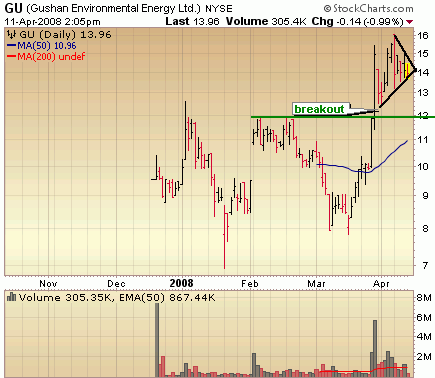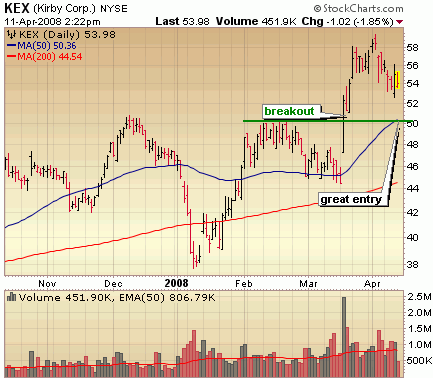
2DIME’S INVESTOR NOTES By: Barry Brush
Technical Analysis of Price & Volume Action Can Give a Trader a Heads Up In the Plunge Protection Game
An article in this morning’s paper gave me cause to reflect upon my last comment on disintermediation and the current state of our nation’s financial markets. The hyperinflationary credit release program which the Federal Reserve began last December has provided a total of $360 billion in short-term loans to credit squeezed banks. 10 times since December 2007 the Fed has opened its discount window to auction off notes at extremely low rates. In the latest auction commercial banks paid an interest rate of 2.87% for their loans. You and I should be so lucky as to find the same rate in our lifetime.
In yesterday’s auction of $50 billion in 28-day loans, there were bidders for $88.3 billion indicating to me that even at lofty levels, there is a significantly higher demand for credit than there are dollars available. One reason for this lack of dollars or bank deposits is a result of the disintermediation I spoke of in my last post on SelfInvestors.com . Have you ever wondered what this below market money is being used for? It certainly isn’t growing moss. What happens if you don’t repay them? I know. You just write them off. No muss no fuss. Poof!
Last Monday April 21st, I Just happened to be watching the 10min chart of "T". Indications were really pointing to a crash of a day given that most markets had moved up to but not through strong overhead resistance on Friday. What I observed was both unsettling and reassuring.
About 10:00 AM, there appeared to be unusual or strange non-human trading patterns occurring which I initially assumed was a corporate buy back in progress or possibly insider trading in anticipation of better than expected earnings. I later became convinced that it was intervention by the shadowy, deep cover grey-ops contractor known as the PPT, (Plunge Protection Team) or WGFM “Working Group on Financial Markets”.* (See Note Below)
I watched “T” sell off repeatedly to $37 exactly and then be miraculously bought back up to $37.90 exactly. I continued to check my monitor throughout the day. Similar price action continued all day at approximately 6 min. intervals; with a 40 min lunch break from 11:50 to 12:30 (So much for the In-human part because computers don’t take lunch breaks) I really haven’t noticed these trading patterns before. Very interesting. After the close, I examined all of the other Dow 30 stocks. With the exception of MSFT and INTC, there were distinct trading pattern similarities to those of “T”. That day the Dow opened around 12850 and headed south quickly. It closed at 12820 up as “planned”. I knew then that I had witnessed a methodical, massive and documented interventionist attack on 28 of the 30 Dow Components in order to prevent a potential sell off and to perpetuate a rally already struggling to take flight. My conclusion Annie, is that “Daddy War-Bucks” is alive, well and a reality.
Attached is a screen shot of “T” for confirmation. All of the other Dow component charts have duplicate price actions. I would appreciate any feed back you might have on my observations or any similar ones of your own. I suppose that if the “lender of last resort” is doing this, it is quasi-legal; and we can now elevate the national opinion of Martha Stewart to a BUY.
This is really good stuff, because it tells me that the Government AKA “The FED” or “us” is serious about protecting today’s Market and economy. However, it goes without saying that, the cost to future American generations will be enormous. In terms of the resulting inflation and the fact that eventually such rigging will destroy the integrity of the markets as free institutions of trading. But that is for someone in the future to worry about. Not us. Our job is to recognize it and to trade on it.
The majority does not want to nor can it see the paradigm shift in the US economy. Over the past 20 years, it has clearly migrated from “laissez-faire” to state control. The switch was thrown 2 decades ago. Darn! I never saw it happen. For you, I and our children, there will be a difference because we see what is going on. State control is not a bad thing for us. We are traders and we are aware of it. So continue to be-aware.
Our strength is in being able to quickly shift our capital to invest in strong companies in strong sectors as the winds of change blow. Rely on price and volume action and technical indicators. They will reveal the “monkey business” going on. A free Market has always had the ability to look ahead 6 months or so and forecast the future strength or weakness of the economy. A concern of mine is that interventions such as the one I witnessed Monday will denigrate the Market’s ability to make that projection. Never underestimate the power of the US Government.
That said, stocks remain one of the best hedges against inflation: but don’t be satisfied with mediocre mutual fund returns. Get involved in the market and stay involved. Make sure your subscription to SelfInvestors.com is kept up to date. Use it!
FYI, I was at a breakfast meeting yesterday with various business leaders in Charlotte, NC. Bob Tourtellot, the owner of an industrial rag company, Wiping Cloths, Inc., said his sales were up 20% over last year. He said rag sales were a reliable leading indicator of the general economy. Go Figure!
Cheers, 2dimes Barry Brush
Note* My thanks to Robert D. McHugh, for thoughts and excerpts from his TechnicalIndicatorIndex Newsletter and Nelson Hultberg’s comments and research below. Nelson Hultberg is a freelance writer in Dallas, Tx. and the Executive Director of Americans for a Free Republic.
Executive Order 12631–Working Group on Financial Markets
The provisions of Executive Order 12631 of Mar. 18, 1988, appear at 53 FR 9421, 3 CFR, 1988 Comp., p. 559, unless otherwise noted.
This order states that the major appointees of this group are to be the Secretary of the Treasury, the Federal Reserve Chairman, the SEC Chairman, and the CFTC Chairman and those they designate to fulfill their purposes. The purposes, as defined in the Executive Order, are to "[enhance] the integrity, efficiency, orderliness, and competitiveness of our Nation’s financial markets and [maintain] investor confidence." The order goes on to say, "To the extent permitted by law and subject to the availability of funds therefore, the Department of the Treasury shall provide the Working Group with such administrative and support services as may be necessary for the performance of its functions."
“The PPT or “Working Group” was authorized by Congress after the crash of 1987. (October 19, 1987 "Black Monday") Its job: to buy markets should declines get out of control. It has become more interventionist than was originally intended under the law. There are no minutes of meetings, no recorded phone conversations, no reports of activities, no announcements of intentions. It is a secret group including the Chairman of the Federal Reserve, the Secretary of the Treasury, the Head of the SEC, and their surrogates which include some of the large Wall Street firms. The original objective was to prevent disastrous market crashes. Lately, it seems, they buy markets when they decide markets need to be bought, including equity markets. Their main resource is the money the Fed “prints”. The money is injected into markets via auctions at the New York Fed’s Repo desk. Once upon a time this would show up in the M-3 numbers, warning intervention was nigh. But, in November 2005, the Fed announced with little comment and no palatable explanation that it would no longer report the M-3 number after March 2006. Without the useful resource of M-3, we need to find other tools to monitor when the PPT is likely to intervene, to instigate or prolong a rally.
For the PPT to be effective in driving markets higher, the potential for a sustained turnaround rally depends upon a high volume of open short interest. By measuring this short interest by the level of CBOE put options, we can gauge when markets are ripe for PPT intervention. The way it works is, the PPT decides markets need intervention, a decline needs to be stopped, or the risks associated with political events that could be perceived by markets as highly negative and cause a decline, need to be prevented by a rally already in flight.
To get that rally, the PPT’s key component is money “given” to surrogates who will take that fresh electronically printed cash and buy markets through some large unknown buyer’s account. That buying comes out of the blue at a time when short interest is high. The unexpected rally strikes blood, and fear overcomes those who were betting the market would drop. These shorts need to cover, need to buy the very stocks they had agreed to sell (without owning them) at today’s prices in anticipation they could buy them in the future at much lower prices and pocket the difference. Seeing those stocks rally above their committed selling price, the shorts are forced to buy — and buy they do. Thus, those most pessimistic about the equity market end up buying equities like mad, fueling the rally that the PPT started. Bingo, a huge turnaround rally is well underway, or a rally already underway is extended, and money from the sidelines; from Hedge Funds, Mutual funds and individuals rushes to join in the buying madness for several days and weeks as the rally gathers a life of its own.”
P.S.:
My belief and observation is that we have just witnessed such a rally; so take advantage and be-aware.














 I have a confession to make. "Trading is as much psychological as it is skill." The skill consists of being able to control the emotions of fear and greed that try to hitch a ride on every trade. It is being able to manage your time while preparing and taking action during the trade itself. Your mental set up is vital; but so too is your physical location and Setup. Depending upon your trading style, you have to be ready to mind the store when the store needs minding. If you have a trade in play and have set mental stops rather than sell stop limits, you’ll need to be available intra-day or after the close to execute your strategy. It goes without saying that your risk in a trade must be managed to a minimum; but your hardware must be flawless as well. Here’s a snapshot of my setup, and the place where I try to manage my risk.
I have a confession to make. "Trading is as much psychological as it is skill." The skill consists of being able to control the emotions of fear and greed that try to hitch a ride on every trade. It is being able to manage your time while preparing and taking action during the trade itself. Your mental set up is vital; but so too is your physical location and Setup. Depending upon your trading style, you have to be ready to mind the store when the store needs minding. If you have a trade in play and have set mental stops rather than sell stop limits, you’ll need to be available intra-day or after the close to execute your strategy. It goes without saying that your risk in a trade must be managed to a minimum; but your hardware must be flawless as well. Here’s a snapshot of my setup, and the place where I try to manage my risk.
